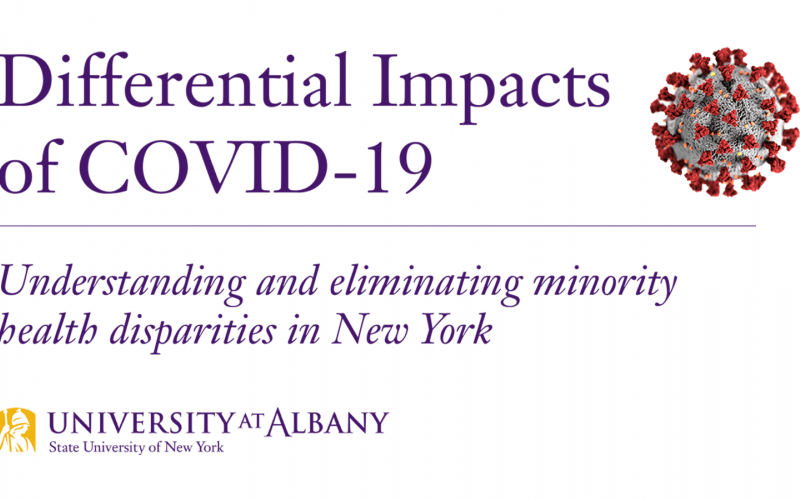Research Team Releases Minority Health Disparities Report, Culminating Year-Long Project

ALBANY, N.Y. (July 1, 2021) – Researchers at the University at Albany have released a report analyzing COVID-19’s disproportionate impact on New York’s communities of color, the culmination of the year-long minority health disparities project begun at the direction of Gov. Cuomo.
The COVID-19 pandemic has delivered many sobering lessons to public health officials and governments across the globe, and among the most pressing has been the disproportionate impact that COVID-19 has had on Black, Hispanic and other minoritized communities.
The work of the UAlbany research team began in the earliest days of the pandemic by analyzing the disproportionate infection, hospitalization and death rates among Black and Hispanic New Yorkers. It then turned to examine the social, economic and environmental dimensions of those disparities, including:
- How the level of risk – and the progression of the disease – differs across minority groups, providing key insights into how to begin to tailor interventions;
- How mitigation measures such as stay-at-home orders affect infection and death, outcomes that also vary by census tract, public transit density and socioeconomic indicators;
- The importance of community health workers and expanding telehealth access in languages other than English and for a variety of health services, including low-risk sexual and reproductive health services;
- The critical role of the Black church in providing accurate and potentially life-saving public health information to congregants;
- The cascading social and economic impacts of the pandemic, including food insecurity; and
- The effects of distrust of the medical community on willingness to vaccinate and participate in contact tracing.
The report serves two primary purposes: to summarize the currently available results of the 14 projects that comprise the COVID-19 minority health disparities research spearheaded by the University, and to describe the new research ecosystem that produced the work, in the hopes that it can serve as a model for others.
The research team explains that minority health disparities are inseparable from broader systemic racism in the United States.
“COVID-19 did not create disparities in health outcomes but rather exposed and exacerbated them in ways policymakers cannot ignore,” they wrote. “Systemic racism has produced, and continues to produce, deeply entrenched differences in health care and the social, economic, and environmental conditions that account for inequities in longevity and the likelihood of disease. This was true long before the first case of COVID-19 was diagnosed in New York on March 1, 2020, and will remain true unless the resources and will exist to make systemic changes.”
Though the report is a product of the governor-directed project, the urgency of the issue led to the creation of a new health equity research ecosystem at UAlbany that will continue long-term. In addition to this report, the researchers have completed several other white papers and other reports that can be viewed on the University’s Scholars’ Archive.
“I am very proud of the work conducted by our outstanding researchers and colleagues at UAlbany and beyond, which led to this excellent report,” said UAlbany President Havidán Rodríguez. “Though the completion of the report is undeniably important, the work must continue and as such, we have now entered the next phase of this critically important initiative with our expanded community of researchers and others committed to health equity for and throughout New York.”
The project would not have been possible without the strong support of SUNY, which provided seed funding, and Chancellor Jim Malatras, who earlier this week participated in a UAlbany-hosted virtual symposium on the differential impacts of COVID-19 featuring the work of dozens of researchers. Several SUNY institutions were partners in the research.
Gov. Cuomo tapped UAlbany to lead the project based the University’s existing research strengths, including the Center for the Elimination of Minority Health Disparities (CEMHD); the first-of-its kind College of Emergency Preparedness, Homeland Security and Cybersecurity (CEHC); and interdisciplinary expertise in public health, social welfare, and public policy, as well as across the arts and sciences and education.
As one of the most diverse research institutions in the country, UAlbany’s student body mirrors the diversity of New York as a whole, and many UAlbany students and their families belong to the same communities disproportionately impacted by the pandemic.
“The trauma inflicted on New Yorkers by the COVID-19 pandemic cannot be undone,” the report concludes. “But university researchers and government policymakers should jointly pledge to do everything in their power not to allow the lessons learned from COVID-19’s unequal path across New York to go unheeded.”
The project team is also collaborating with the Healthcare Association of New York State on a webinar series, Turning the Tide: Understanding and Eliminating Minority Health Disparities. To register for an upcoming webinar, visit the event website.




